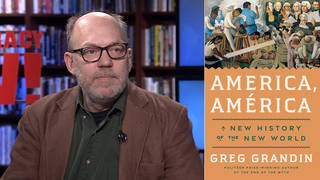
The Supreme Court considers Friday whether to take up the case of Rodney Reed, an African-American death row prisoner in Texas who is scheduled to be executed in less than a week for a murder he says he did not commit. On Thursday, Reed’s family braved the cold to camp outside the Supreme Court for a vigil asking the justices to help halt the execution. Millions of people around the country have joined their cause in recent weeks amid mounting evidence that another man may be responsible for the 1996 murder of Stacey Stites, a 19-year-old white woman. In 1998, an all-white jury sentenced Reed to die for Stites’s murder after his DNA was found inside her body. The two were having an affair at the time of her death. But new and previously ignored details in the case indicate that Stites’s then-fiancé, a white police officer named Jimmy Fennell, may in fact be responsible for the killing. Last month, a man who spent time in jail with Fennell signed an affidavit saying Fennell had admitted in prison to killing his fiancée because she was having an affair with a black man. Despite this, Reed’s execution is scheduled for November 20. We speak with Maurice Chammah, a staff writer at The Marshall Project.
Transcript
AMY GOODMAN: This is Democracy Now! I’m Amy Goodman. Is Texas about to kill an innocent man? We turn now to the case of Rodney Reed, an African-American death row prisoner who’s scheduled to be executed in less than a week for a murder he says he did not commit. On Thursday, Reed’s family braved the cold to host a vigil outside the Supreme Court, asking the justices to take up Reed’s case and help halt his execution. Millions around the country have joined the family’s cause in recent weeks amidst mounting evidence that another man may be responsible for the 1996 murder of Stacey Stites, a 19-year-old white woman.
In 1998, an all-white jury sentenced Reed to die for Stacey’s murder after his DNA was found inside her body. The two were having an affair at the time of her death. But new and previously ignored details in the case indicate that Stacey Stites’ then-fiancé, a white police officer named Jimmy Fennell, may in fact have been responsible for the murder. Fennell was later jailed on kidnapping and rape charges in another case. Last month, a man who spent time in jail with Fennell signed an affidavit saying he had admitted in prison to killing his fiancée because she was having an affair with a black man. Despite this, Rodney Reed’s execution is still scheduled for next Wednesday, November 20th. Texas Governor Greg Abbott has not responded to the growing calls to halt the killing, including from Republican and Democratic state lawmakers and celebrities, including Oprah and Kim Kardashian and Rihanna.
Well, for more, we go to Austin, Texas, where we’re joined by Maurice Chammah, a staff writer at The Marshall Project, his most recent article headlined “How Do You Prove You’re Innocent If You’re on Death Row?” His forthcoming book about the death penalty won the 2019 J. Anthony Lukas Work-in-Progress Book Award.
Welcome to Democracy Now!, Maurice. Lay out this case. Tell us the story of what’s taken place, beginning with the murder.
MAURICE CHAMMAH: So, in the mid-'90s, Rodney Reed was arrested for the murder of Stacey Stites, as you said, this 19-year-old white woman. This was in Bastrop, Texas. It had taken police about a year to find, you know, even a suspect and arrest someone. There were a lot of leads that they went down, and they had a lot of trouble figuring it out. Eventually, they found semen of Rodney Reed at the crime scene and on the body of his victim, and they deduced that he had raped her and killed her. And they took him to trial and sentenced him to death, and he's been on death row ever since.
Even in the early 2000s, just a few years after he was on death row, there started to be questions about the case. There was reporting. You know, at The Austin Chronicle, Jordan Smith started looking into the case. She was a reporter there at the time. And the state’s case sort of slowly came undone. There was a forensic piece of it that, you know, initially, when they had looked at the body of the victim, it had seemed as though she had been killed in one time frame — that’s where Rodney Reed was sent to death row over. But it turned out, actually, that the forensics behind, you know, the death investigation were flawed and that, actually, she had died many hours earlier. And it was hours with – which she was with her fiancé at the time, Jimmy Fennell. He was a police officer in Bastrop.
Then, over the course of the years, new bits of evidence trickle out. People say that they knew the victim, Stacey Stites, and that she talked about how she was afraid of her fiancé, that she was having an affair with a black man in this town that was still very conservative, and that she was — you know, didn’t know what would happen if this came out, if her fiancé found out. Right? And Jimmy Fennell made more and more incriminating statements.
And the case just sort of plowed on through appeals, like many death penalty cases do. And now we’re at the point where he has lost — Rodney Reed has lost in court multiple times. And he has gone to federal and state courts, the Supreme Court. And now, you know, he has a few remaining appeals in these different courts, that we’ll see how they get ruled on, but his sort of last-ditch effort is to get a stay of execution from Governor Greg Abbott, the governor of Texas, who sort of has the ultimate authority at the end. And that’s where the political pressure from celebrities, as you’ve mentioned, and lawmakers — even Ted Cruz has weighed in to say that, you know, the courts and the state should be careful before executing this man, should really look at the evidence to make sure he’s really the one who did it. You’re seeing a kind of unique amount of awareness and pressure coming into this case to push the governor to stop the execution.
AMY GOODMAN: And talk more about Jimmy Fennell. He was the white police officer — at the time, of course, her fiancé, as you’re just saying. I mean, this man ends up going to jail for years, after Stacey Stites is murdered. And remember, at the time, it’s his fellow officers who were investigating this case. He ends up going to jail for years for rape and violence.
MAURICE CHAMMAH: That’s right. I mean, we shouldn’t assume that because you commit one crime, you’ve committed another. You know, Jimmy Fennell is still presumed innocent until or unless he’s proven guilty. And he has denied, through a lawyer, that he murdered his fiancée in the mid-’90s. And he, you know, like many people, sort of maintains that Rodney Reed did it.
That said, the number of incriminating statements over the years, the fact that he told a fellow prisoner that he had killed her, the fact that she was afraid of him, it all paints a fairly compelling picture. And it’s certainly a compelling-enough picture that it has caused many, many people to say, “Well, we don’t really know. And if anything, it’s almost — you know, executing somebody on this evidence is a potential terrible travesty.”
AMY GOODMAN: Could he actually be put to death with all of this evidence?
MAURICE CHAMMAH: Oh, absolutely. And, in fact, Rodney Reed is not the first person to be put to death in Texas or in other states despite fairly compelling evidence. And that’s where I think that this case is sort of a teachable moment for all of us when it comes to the death penalty and the sort of legal system that surrounds it. One would think that, you know, very, very compelling evidence of innocence would stop an execution. But over time, Congress and various state legislatures and the courts have restricted the ability of prisoners, not just on death row, but to present evidence that they did not commit the crime. There’s this assumption that the trial should be the end of it and that there should be a kind of finality in these cases, and so courts are very, very loathe, overall, to reverse these death sentences —
AMY GOODMAN: Among many others —
MAURICE CHAMMAH: — because they think, “Well, the jury figured it out.”
AMY GOODMAN: Among many others, police officers have stepped forward to say that Rodney Reed should not be executed. So, you have the governor, but also the parole board of Texas — right? — could weigh in?
MAURICE CHAMMAH: That’s right. So, in order for Rodney Reed to really be free from death row, there needs to be a recommendation from the Texas Board of Pardons and Paroles. This is a board that’s appointed by the governor, by Governor Greg Abbott. We don’t know exactly how they make their decisions, but a decade or two ago the board members were fairly open that they would not do things that the governor was displeased with. They sort of felt beholden to the governor. This was certainly the case under Governor George Bush in the ’90s. You know, his board members admitted this. And so, we see with —
AMY GOODMAN: We’re going to have to leave it there, but we’re going to continue to cover this issue.
MAURICE CHAMMAH: All right.
AMY GOODMAN: The death date is set for November 20th. Maurice Chammah, we’ll link to your piece at The Marshall Project. And folks should go to democracynow.org to see our interview with Rodney’s brother and sister-in-law, as well as his lawyer.
Democracy Now! is currently accepting applications for paid six-month internships here in our New York City studio. Go to democracynow.org for details. I’m Amy Goodman. Thanks so much for joining us.













Media Options